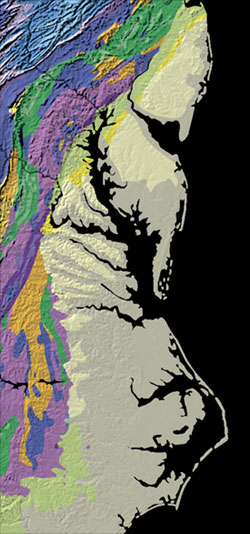Fall Line
| Atlantic Seaboard fall line | |
| Fall line | |
| Nickname: Piedmont—Coastal Plain fall line | |
| Country | United States |
|---|---|
| North endpoint South endpoint |
New Jersey Carolinas or Georgia |
| Length | 900 mi (1,400 km) |
|
Map showing part of the Eastern Seaboard Fall Line where the pale colored coastal plain meets the brightly colored Piedmont.
|
|
A fall line (or fall zone) is the geomorphologic break that demarcates the border between an upland region of relatively hard crystalline basement rock and a coastal plain of softer sedimentary rock. A fall line is typically prominent when crossed by a river, for there will often be rapids or waterfalls. Many times a fall line will recede upstream as the river cuts out the uphill dense material, often forming “c”-shaped waterfalls. Because of these features riverboats typically cannot travel any farther inland without portaging, unless locks are built there. On the other hand, the rapid change in elevation of the water, and the resulting energy release, makes the fall line a good location for water mills, grist mills, and sawmills. Because of the need for a river port leading to the ocean, and a ready supply of water power, settlements often develop where rivers cross a fall line.
The slope of fall zones on rivers played a role in settlement patterns. For example, the fall line represents the inland limit of navigation on many rivers. As such, many fall line cities grew around transferring people and goods between land-based and water-based transportation at this point. Also, fall lines proved useful for hydroelectric dams such as those at Rochester, New York (on the Niagara Escarpment), at Columbia, South Carolina, and at Conowingo, Maryland, on the Susquehanna River (on the Atlantic Seaboard fall line). Cities established along fall lines in the United States include:
The Atlantic Seaboard Fall Line, or Fall Zone, is a 900-mile (1,400 km) escarpment where the Piedmont and Atlantic Coastal Plain meet in the eastern United States. Much of the Atlantic Seaboard fall line passes through areas where no evidence of faulting is present.
...
Wikipedia

